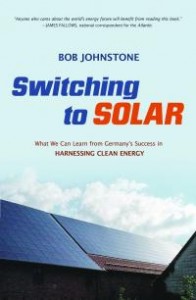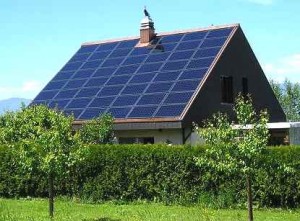I’m writing this post, sitting outside, overlooking a pool sparkling in the sunshine. OK, not really but it gets your mind in the right place – a sunny day. Solar energy has been gaining ground in both the U.S. and especially Europe so I thought it was high-time I learn more about the history of solar. “Switching to Solar,” by Bob Johnstone should become the industry and consumer reference to the worldwide solar story.
I have to admit that reading books on energy, environment and ag can be a bit dry regardless of the veracity of the information. But Johnstone broke the mold with his engaging story telling, compelling information and insights on the solar industry. It probably helps that he is a journalist,  but he takes us through the history of solar weaving through Europe and taking a stop in Germany and coming back to the States – a country that was winning and now is losing, the solar technology race to countries overseas such as China.
but he takes us through the history of solar weaving through Europe and taking a stop in Germany and coming back to the States – a country that was winning and now is losing, the solar technology race to countries overseas such as China.
There are several issues that are discussed in the book that are of special importance to the solar industry: rate of conversion, subsidies/tariffs, industry viability, legislation, and technology. He also talks about overcoming utility resistance to renewable energy and their adoption to both energy efficiency strategies and the adoption of renewable energy. Two areas he didn’t discuss in detail are the challenges with storage and transmission lines/ smart grid issues.
He writes, “For utilities, promoting energy efficiency was an unnatural act. Thus far, their entire rationale had been to encourage customers to use more energy, not less. their rate structure was designed to reward consumption, by charging customers less for the additional kilowatt-hours they used. Their domestic sales departments came up with promotional gimmicks to encourage usage. Utility salespeople gleefully handed out free hair dryers to their customers.”
See this ladies. It’s the utility companies’ fault that we’re contributing to global climate change with our old school hairdryers.
Just kidding folks. Seriously though, this mentally was, and in some cases, continues to be a problem when consumers who install solar power systems try to sell their excess power to the utility company. A point well discussed in the book.
I want to focus for a minute on Germany’s and subsequently other countries use of feed-in tariffs. Many people are opposed to this route, especially in the U.S., but the book shows that love ’em or hate ’em they spur a much more aggressive rate of adoption. Ironically, when people want to put a solar success story on the pedestal, they use Germany, and when people want to show the worst example of solar gone wrong, they use Germany.
 “Why has the German feed-in tariff model been so successful? In large part, because it is simple to understand,” writes Johnstone. “Especially compared to the confusing melange of bureaucratic mechanisms employed elsewhere. With feed-in tariffs the utilities are responsible for paying for the provision of clean energy.”
“Why has the German feed-in tariff model been so successful? In large part, because it is simple to understand,” writes Johnstone. “Especially compared to the confusing melange of bureaucratic mechanisms employed elsewhere. With feed-in tariffs the utilities are responsible for paying for the provision of clean energy.”
And that my friends lies one of the biggest problems with adding renewable energy, such as solar power, to the grid. No one, especially utilities, want to pay for it. Consumers want the utilities to pay for it and the utilities want the government to pay for it, and while everyone argues round and round the circle, the smart grid fails to materialize and the growth of solar power stalls.
Let me jump down from my stump and say, yes, Johnstone’s book got me fired up a bit, but in a good way. He discusses challenges and opportunities without passing judgement on what’s right or wrong and leaves us thinking about the future technology of solar panels – and if he is correct, an exciting one it will be.

